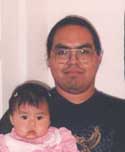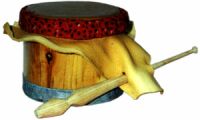Native American Rhythms
 Thanks
to Tachini Pete of DrumHoops.com
for helping us put together this long overdue page. (Pete's shown
at left, with his daughter.) Thanks
to Tachini Pete of DrumHoops.com
for helping us put together this long overdue page. (Pete's shown
at left, with his daughter.)
Introduction to Native American Drumming
© 2002 Tachini Pete
Native Americans, people with an ancestral link to the indigenous
people of North America are like people on many other continents.
There are different customs as related to the drum which vary vastly
from region to region and tribe to tribe. The same can be said of
the drums. The drum to most natives is central to the community
or ceremony. It is considered by many to be the heartbeat of the
Earth. They vary from the large community drums to the small hand
held drums. In native circles these drums, “pumin” (poo-meen)
in Salish, are referred to as hand drums, powwow drums, water drums,
peyote drums. In general, all drums are used with some form of beater
or drumstick. As well, all drums are used for prayer and spiritual
ceremonies or at least have a connection to such.
The hand drums range in size from 6” – 20”
in diameter, and they are usually about 2”-4” in depth.
These drums have many different uses which very from tribe to tribe.
In the powwow scene they are used when singing round dance songs.
These have become very popular competitions at many gatherings.
They are also used in gambling, in a game called stickgame or handgame.
Most non-Indians know these drums as shaman drums because
of their use in many different spiritual ceremonies.
The powwow drums are the large drums, sometime referred
to as community drums or council drums. These are
large drums usually with two heads. The heads can be made of just
about any large animal. Often the heads are elk, moose, buffalo,
horse, or cow. These drums produce a deep thunderous sound.
 Water
drums actually contain water. They have a very distinct sound.
The movement of the drum and water changes the sound. Peyote
drums are small drums used in Peyote ceremonies. These are small
single head drums with different shapes. (Photo thanks to ohwejagehka.com) Water
drums actually contain water. They have a very distinct sound.
The movement of the drum and water changes the sound. Peyote
drums are small drums used in Peyote ceremonies. These are small
single head drums with different shapes. (Photo thanks to ohwejagehka.com)
Alaskan Drums: Alaskan natives and northern indigenous people
use a large single head drum about 20” – 24” in diameter.
These were traditionally made using whale or seal stomach or other
innards membrane linings. This is a very delicate procedure and
because of this most drums today are made of synthetic fabrics.
The songs and uses vary among the many communities and groups of
the northern regions of the North America.
The rhythms and songs are so numerous across the continent
that it can’t be said there is a common one. Even in powwows
there are many different styles, rhythms and songs. Other percussion
instruments are rattles, blankets, and wood. Rattles come
in many different forms. They can be gourd rattles, rawhide rattles,
hoof rattles, wooden rattles, tooth rattles and many more. In
some cultures blankets (traditionally buckskin) were used
like drums. Stretched by many people and beat with a stick. Wood
was used as well in many different ways to create rhythm and song.
To a native singer just about anything that makes a beat became
a temporary drum atone time or another.
Links
http://www.powwows.com/
http://www.blackhorsenativeamer.com/
Native
American Art and Culture
The
Power of Kiowa Song (Peyote songs)
Iroquois
Earth Songs
The Six Nations of the Great River (Iroquois) include the Seneca
and the Mohawk tribes
|

